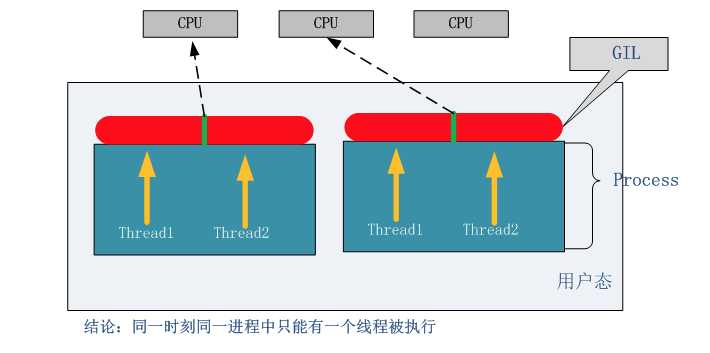标签:rod 执行 通过 9.png adc 文本处理 style join lis
Python作为一种解释型语言,由于使用了全局解释锁(GIL)的原因,其代码不能同时在多核CPU上并发的运行。这也导致在Python中使用多线程编程并不能实现并发,我们得使用其他的方法在Python中实现并发编程。
Python中不能通过使用多线程实现并发编程主要是因为全局解释锁的机制,所以首先解释一下全局解释锁的概念。
首先,我们知道C++和Java是编译型语言,而Python则是一种解释型语言。对于Python程序来说,它是直接被输入到解释器中直接运行的。解释器在程序执行之前对其并不了解;它所知道的只是Python的规则,以及在执行过程中怎样去动态的应用这些规则。它也有一些优化,但是这基本上只是另一个级别的优化。由于解释器没法很好的对程序进行推导,Python的大部分优化其实是解释器自身的优化。更快的解释器自然意味着程序的运行也能“免费”的更快。也就是说,解释器优化后,Python程序不用做修改就可以享受优化后的好处。
为了利用多核系统,Python必须支持多线程运行。但作为解释型语言,Python的解释器需要做到既安全又高效。解释器要注意避免在不同的线程操作内部共享的数据,同时还要保证在管理用户线程时保证总是有最大化的计算资源。为了保证不同线程同时访问数据时的安全性,Python使用了全局解释器锁(GIL)的机制。从名字上我们很容易明白,它是一个加在解释器上的全局(从解释器的角度看)锁(从互斥或者类似角度看)。这种方式当然很安全,但它也意味着:对于任何Python程序,不管有多少的处理器,任何时候都总是只有一个线程在执行。即:只有获得了全局解释器锁的线程才能操作Python对象或者调用Python/C API函数。
所以,在Python中”不要使用多线程,请使用多进程”。具体来说,如果你的代码是IO密集型的,使用多线程或者多进程都是可以的,多进程比线程更易用,但是会消耗更多的内存;如果你的代码是CPU密集型的,多进程(multiprocessing模块)就明显是更好的选择——特别是所使用的机器是多核或多CPU的时候。
另外,Python的官方实现CPython带有GIL,但并不是所有的Python实现版本都是这样的。IronPython,Jython,还有使用.NET框架实现的Python就没有GIL。所以如果你不能忍受GIL,也可以尝试用一下其他实现版本的Python。

如果是一个计算型的任务,GIL就会让多线程变慢。我们举个计算斐波那契数列的例子:
这种情况还不如不用多线程!
GIL是必须的,这是Python设计的问题:Python解释器是非线程安全的。这意味着当从线程内尝试安全的访问Python对象的时候将有一个全局的强制锁。 在任何时候,仅仅一个单一的线程能够获取Python对象或者C API。每100个字节的Python指令解释器将重新获取锁,这(潜在的)阻塞了I/O操作。因为锁,CPU密集型的代码使用线程库时,不会获得性能的提高。
那是不是由于GIL的存在,多线程库就是个「鸡肋」呢?当然不是。事实上我们平时会接触非常多的和网络通信或者数据输入/输出相关的程序,比如网络爬虫、文本处理等等。这时候由于网络情况和I/O的性能的限制,Python解释器会等待读写数据的函数调用返回,这个时候就可以利用多线程库提高并发效率了。
A. Semaphore(信号量)
在多线程编程中,为了防止不同的线程同时对一个公用的资源(比如全部变量)进行修改,需要进行同时访问的数量(通常是1)的限制。信号量同步基于内部计数器,每调用一次acquire(),计数器减1;每调用一次release(),计数器加1.当计数器为0时,acquire()调用被阻塞。
import time
from random import random
from threading import Thread,Semaphore,current_thread,enumerate
sema = Semaphore(3)
def foo(tid):
with sema:
print(‘{} acquire sema‘.format(tid))
wt = random() * 2
time.sleep(wt)
print(‘{} release sema‘.format(tid))
for i in range(5):
t = Thread(target=foo,args=(i,))
t.start()
main_thread = current_thread()
for t in enumerate():
if t is main_thread:
continue
t.join()
####输出结果#####
0 acquire sema
1 acquire sema
2 acquire sema
0 release sema
3 acquire sema
1 release sema
4 acquire sema
2 release sema
3 release sema
4 release sema
B. Lock(互斥锁)
Lock也可以叫做互斥锁,其实相当于信号量为1。我们先看一个不加锁的例子:
import time
import threading
value = 0
def getlock():
global value
new = value + 1
time.sleep(0.001) # 让线程有机会切换
value = new
for i in range(100):
t = threading.Thread(target=getlock)
t.start()
main_thread = threading.current_thread()
for t in threading.enumerate():
if t == main_thread:
continue
t.join()
print(value)
####输出结果#####
不确定(刷新值会发生改变)
现在,我们来看看加锁之后的情况:

1 import time 2 import threading 3 4 value = 0 5 lock = threading.Lock() 6 7 def getlock(): 8 global value 9 with lock: 10 new = value + 1 11 time.sleep(0.001) # 让线程有机会切换 12 value = new 13 14 for i in range(100): 15 t = threading.Thread(target=getlock) 16 t.start() 17 18 main_thread = threading.current_thread() 19 20 for t in threading.enumerate(): 21 if t == main_thread: 22 continue 23 t.join() 24 25 print(value) 26 27 ####输出结果为#############
我们对value的自增加了锁,就可以保证了结果了。
先来说说死锁,所谓死锁: 是指两个或两个以上的进程或线程在执行过程中,因争夺资源而造成的一种互相等待的现象,若无外力作用,它们都将无法推进下去。此时称系统处于死锁状态或系统产生了死锁,这些永远在互相等待的进程称为死锁进程。
import threading
import time
mutexA = threading.Lock()
mutexB = threading.Lock()
class MyThread(threading.Thread):
def __init__(self):
threading.Thread.__init__(self)
def run(self):
self.fun1()
self.fun2()
def fun1(self):
mutexA.acquire() # 如果锁被占用,则阻塞在这里,等待锁的释放
print ("I am %s , get res: %s---%s" %(self.name, "ResA",time.time()))
mutexB.acquire()
print ("I am %s , get res: %s---%s" %(self.name, "ResB",time.time()))
mutexB.release()
mutexA.release()
def fun2(self):
mutexB.acquire()
print ("I am %s , get res: %s---%s" %(self.name, "ResB",time.time()))
time.sleep(0.2)
mutexA.acquire()
print ("I am %s , get res: %s---%s" %(self.name, "ResA",time.time()))
mutexA.release()
mutexB.release()
if __name__ == "__main__":
print("start---------------------------%s"%time.time())
for i in range(0, 10):
my_thread = MyThread()
my_thread.start()
解决方案:
import threading
import time
mutex = threading.RLock()
class MyThread(threading.Thread):
def __init__(self):
threading.Thread.__init__(self)
def run(self):
self.fun1()
self.fun2()
def fun1(self):
mutex.acquire() # 如果锁被占用,则阻塞在这里,等待锁的释放
print ("I am %s , get res: %s---%s" %(self.name, "ResA",time.time()))
mutex.acquire()
print ("I am %s , get res: %s---%s" %(self.name, "ResB",time.time()))
mutex.release()
mutex.release()
def fun2(self):
mutex.acquire()
print ("I am %s , get res: %s---%s" %(self.name, "ResB",time.time()))
time.sleep(0.2)
mutex.acquire()
print ("I am %s , get res: %s---%s" %(self.name, "ResA",time.time()))
mutex.release()
mutex.release()
if __name__ == "__main__":
print("start---------------------------%s"%time.time())
for i in range(0, 10):
my_thread = MyThread()
my_thread.start()
递归锁内部维护了一个计数器,当有线程拿到了Lock以后,这个计数器会自动加1,只要这计数器的值大于0,那么其他线程就不能抢到改锁,这就保证了,在同一时刻,仅有一个线程使用该锁,从而避免了死锁的方法。关于递归锁内部实现,有兴趣的可以看看源码。
一个线程等待特定条件,而另一个线程发出特定条件满足的信号。最好说明的例子就是「生产者/消费者」模型:
import time
import threading
def consumer(cond):
t = threading.current_thread()
with cond:
cond.wait() # 创建了一个锁,等待producer解锁
print(‘{}: Resource is available to consumer‘.format(t.name))
def producer(cond):
t = threading.current_thread()
with cond:
print(‘{}:Making resource available‘.format(t.name))
cond.notifyAll() # 释放锁,唤醒消费者
condition = threading.Condition()
c1 = threading.Thread(name=‘c1‘,target=consumer,args=(condition,))
p = threading.Thread(name=‘p‘,target=producer,args=(condition,))
c2 = threading.Thread(name=‘c2‘,target=consumer,args=(condition,))
c1.start()
time.sleep(1)
c2.start()
time.sleep(1)
p.start()
一个线程发送/传递事件,另外的线程等待事件的触发。我们同样的用「生产者/消费者」模型的例子:
import time
import threading
from random import randint
TIMEOUT = 2
def consumer(event, l):
t = threading.currentThread()
while 1:
event_is_set = event.wait(TIMEOUT)
if event_is_set:
try:
integer = l.pop()
print(‘{} popped from list by {}‘.format(integer,t.name))
event.clear() # 重置状态
except IndexError:
pass
def producer(event, l):
t = threading.currentThread()
while 1:
integer = randint(10,100)
l.append(integer)
print(‘{} append to list by {}‘.format(integer, t.name))
event.set()
time.sleep(1)
event = threading.Event()
l = []
threads = []
p = threading.Thread(name=‘producer1‘, target=producer, args=(event, l))
p.start()
threads.append(p)
for name in (‘consumer1‘,‘consumer2‘):
t = threading.Thread(target=consumer, name=name, args=(event, l))
t.start()
threads.append(t)
for t in threads:
t.join()
print(‘ending‘)
可以看到事件被2个消费者比较平均的接收并处理了。如果使用了wait方法,线程就会等待我们设置事件,这也有助于保证任务的完成。
队列在并发开发中最常用的。我们借助「生产者/消费者」模式来理解:生产者把生产的「消息」放入队列,消费者从这个队列中对去对应的消息执行。
大家主要关心如下4个方法就好了:
put: 向队列中添加一个消息。
get: 从队列中删除并返回一个消息。
task_done: 当某一项任务完成时调用。
join: 阻塞直到所有的项目都被处理完。
import time
import threading
import random
import queue
q = queue.Queue()
def double(n):
return n*2
def producer():
while 1:
wt = random.randint(1,10)
time.sleep(random.random())
q.put((double, wt))
def consumer():
while 1:
task, arg = q.get()
print(arg, task(arg))
q.task_done()
for target in (producer, consumer):
t = threading.Thread(target=target)
t.start()
Queue模块还自带了PriorityQueue(带有优先级)和LifoQueue(先进先出)2种特殊队列。我们这里展示下线程安全的优先级队列的用法,
PriorityQueue要求我们put的数据的格式是(priority_number, data),我们看看下面的例子:
import time
import threading
from random import randint
import queue
q = queue.PriorityQueue()
def double(n):
return n * 2
def producer():
count = 0
while 1:
if count > 5:
break
prit = randint(0,100)
print("put :{}".format(prit))
q.put((prit, double, prit)) # (优先级,函数,参数)
count += 1
def consumer():
while 1:
if q.empty():
break
pri,task,arg = q.get()
print(‘[PRI:{}] {} * 2 = {}‘.format(pri,arg,task(arg)))
q.task_done()
time.sleep(0.1)
t = threading.Thread(target=producer)
t.start()
time.sleep(1)
t = threading.Thread(target=consumer)
t.start()
面向对象开发中,大家知道创建和销毁对象是很费时间的,因为创建一个对象要获取内存资源或者其它更多资源。无节制的创建和销毁线程是一种极大的浪费。那我们可不可以把执行完任务的线程不销毁而重复利用呢?仿佛就是把这些线程放进一个池子,一方面我们可以控制同时工作的线程数量,一方面也避免了创建和销毁产生的开销。
import time
import threading
from random import random
import queue
def double(n):
return n * 2
class Worker(threading.Thread):
def __init__(self, queue):
super(Worker, self).__init__()
self._q = queue
self.daemon = True
self.start()
def run(self):
while 1:
f, args, kwargs = self._q.get()
try:
print(‘USE:{}‘.format(self.name))
print(f(*args, **kwargs))
except Exception as e:
print(e)
self._q.task_done()
class ThreadPool(object):
def __init__(self, max_num=5):
self._q = queue.Queue(max_num)
for _ in range(max_num):
Worker(self._q) # create worker thread
def add_task(self, f, *args, **kwargs):
self._q.put((f, args, kwargs))
def wait_compelete(self):
self._q.join()
pool = ThreadPool()
for _ in range(8):
wt = random()
pool.add_task(double, wt)
time.sleep(wt)
pool.wait_compelete()
标签:rod 执行 通过 9.png adc 文本处理 style join lis
原文地址:https://www.cnblogs.com/xiongmozhou/p/9097968.html